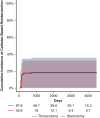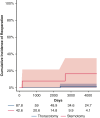Sternotomy or thoracotomy for neonatal repair of coarctation of the aorta with aortic arch hypoplasia
- PMID: 39780815
- PMCID: PMC11704562
- DOI: 10.1016/j.xjon.2024.10.001
Sternotomy or thoracotomy for neonatal repair of coarctation of the aorta with aortic arch hypoplasia
Abstract
Objective: For neonatal repair of coarctation of the aorta, patients may either undergo thoracotomy with extended end-to-end anastomosis or sternotomy for aortic arch reconstruction with cardiopulmonary bypass. The objective of this study was to evaluate the comparative effectiveness of the 2 approaches in patients with arch hypoplasia.
Methods: This is a single-center retrospective cohort study from July 2005 through May 2022 of patients who underwent neonatal repair for isolated coarctation of the aorta with additional arch hypoplasia. Inverse probability of treatment weighting is a statistical method for creating comparable pseudopopulations and was used to account for baseline differences in population. The primary outcome was aortic reintervention, and secondary outcomes were vocal cord dysfunction, length of stay, chylothorax, and phrenic nerve palsy.
Results: There were 130 patients who met inclusion criteria. After weighting, the interaction between distal transverse arch size and operative approach (sternotomy vs thoracotomy) was statistically significant, P < .05 for interaction. Among patients with a distal arch z-score <-3.5, patients undergoing thoracotomy with extended end-to-end anastomosis had an increased hazard for reintervention. Sternotomy was associated with an increased length of stay in the intensive care unit by 4.7 days, P < .001, and odds of vocal cord dysfunction were also greater, odds ratio 7.1 (95% confidence interval, 1.66 to 41.26; P = .01).
Conclusions: Among patients with a distal arch z-score smaller than -3.5, the hazard of reintervention was increased for patients undergoing thoracotomy with extended end-to-end anastomosis. However, length of stay and risk of vocal cord paresis was reduced in patients undergoing thoracotomy.
Keywords: aortic arch hypoplasia; aortic arch reconstruction; coarctation of the aorta; neonatal arch.
© 2024 The Author(s).
Conflict of interest statement
The authors reported no conflicts of interest. The Journal policy requires editors and reviewers to disclose conflicts of interest and to decline handling or reviewing manuscripts for which they may have a conflict of interest. The editors and reviewers of this article have no conflicts of interest.
Figures









Similar articles
-
Arch Augmentation via Median Sternotomy for Coarctation of Aorta With Proximal Arch Hypoplasia.Ann Thorac Surg. 2018 Oct;106(4):1214-1219. doi: 10.1016/j.athoracsur.2018.04.025. Epub 2018 May 16. Ann Thorac Surg. 2018. PMID: 29753817
-
A single centre experience with an evolving approach for the repair of coarctation of the aorta.Cardiol Young. 2019 Jul;29(7):885-887. doi: 10.1017/S104795111900101X. Epub 2019 Jul 12. Cardiol Young. 2019. PMID: 31296278 Free PMC article.
-
Proximal Arch in Left Thoracotomy Repair of Neonatal and Infant Coarctation-How Small Is Too Small?World J Pediatr Congenit Heart Surg. 2019 Jul;10(4):469-474. doi: 10.1177/2150135119852329. World J Pediatr Congenit Heart Surg. 2019. PMID: 31307310
-
Transverse aortic arch obstruction: when to go from the front.Semin Thorac Cardiovasc Surg Pediatr Card Surg Annu. 2009:66-9. doi: 10.1053/j.pcsu.2009.01.024. Semin Thorac Cardiovasc Surg Pediatr Card Surg Annu. 2009. PMID: 19349017 Review.
-
The neonatal hypoplastic aortic arch: decisions and more decisions.Semin Thorac Cardiovasc Surg Pediatr Card Surg Annu. 2013;16(1):43-51. doi: 10.1053/j.pcsu.2013.01.008. Semin Thorac Cardiovasc Surg Pediatr Card Surg Annu. 2013. PMID: 23561817 Review.
References
-
- Mitchell S.C., Korones S.B., Berendes H.W. Congenital heart disease in 56,109 births incidence and natural history. Circulation. 1971;43(3):323–332. - PubMed
-
- Kaushal S., Backer C.L., Patel J.N., et al. Coarctation of the aorta: midterm outcomes of resection with extended end-to-end anastomosis. Ann Thorac Surg. 2009;88(6):1932–1938. - PubMed
-
- Karl T.R., Sano S., Brawn W., Mee R.B.B. Repair of hypoplastic or interrupted aortic arch via sternotomy. J Thorac Cardiovasc Surg. 1992;104(3):688–695. - PubMed
-
- Wu M.H., Chen H.C., Kao F.Y., Huang S.K. Risk of systemic hypertension and cerebrovascular accident in patients with aortic coarctation aged <60 years (from a national database study) Am J Cardiol. 2015;116(5):779–784. - PubMed
LinkOut - more resources
Full Text Sources
Miscellaneous

